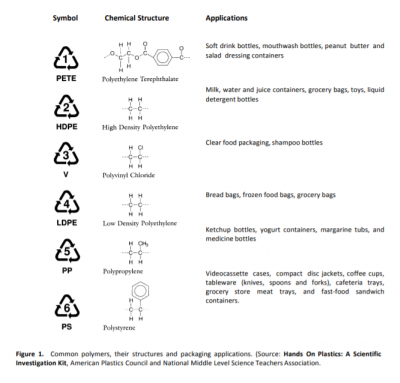Pollution Prevention Curriculum
Unit 4: Plastics
Pre-activity
- Look around the room and find as many plastic objects as you can in ten seconds...GO!
- Think about the pros and cons of plastic.
- How is it beneficial? (pros: convenient, medical products (e.g. tubing, contact lenses, and other devices), hygienic packaging, lightweight, durable)
- What are the cons? (pollution, non-biodegradable, climate change concerns, uses non-renewable resources, encourages the use of single-use products)
- Are there any aspects to plastics that are both pros and cons? (e.g. long lifespan)
Activity 1:
Waste Inventory
For one day, record everything you throw away. You can group types of garbage into categories and keep tally marks to track how much you throw away. Before you begin, predict how many items you will throw away in 24 hours.
Discussion:
- Identify the items you disposed of that were intended for single-use versus items intended to be durable.
- What types of items did you discard that could become microplastics?
- How could these items end up in the river or ocean?
- How can you prevent these items from polluting the environment?
- Does recycling an item prevent it from contributing to pollution?
- How different would your results look if you extended the the study to a week? A month? (Maybe you didn’t purchase anything packaged in plastic during your 24 hours, but how many do you buy in a week or month?).
- What are you already doing to reduce the amount of plastic waste polluting the environment?
- How could you produce less waste?
- Is there anything you could do to use your individual actions to inspire bigger actions?
Activity 2:
What happens to plastic in the water?
Supplies: bucket or large container, various plastic objects
There are many different kinds of plastics and when they are in the water, some float, others sink, and some remain neutrally buoyant. One factor affecting where plastics end up in the water column is density. Remember, density is the ratio of the material’s mass to its volume, and the density of a material is always the same regardless of the size of the object. The impacts of plastic pollution on specific animals or species vary depending on whether the plastic floats or sinks (think about animals that feed on the bottom versus the surface). Plastic pollution can affect animals through consumption, entanglement, or leaching toxic chemicals. In this test, you will observe how the density of plastic affects its location in the water column.

Directions:
- Collect various plastic items (e.g. plastic fork, plastic bag, DVD case, bottles, etc).
- Identify the type of plastic (marked on the object). Compare the recycling symbol to the chart.to determine the type of plastic and see its applications.
- Predict whether each item will sink or float (items denser than water will sink and items less dense than water will float).
- Make a chart to record the item name, type of plastic, and your prediction.
- Fill your container with tap water (your container should be large enough to submerge your items. If it is not, you may cut your plastic item into smaller pieces).
- Submerge the item and record your observations. NOTE: If your item is not completely submerged it will appear to float due to surface tension.
- Which items floated? Which sank? Why?
- You can take this experiment a step further by adding salt to the water. Saltwater is denser than freshwater. Are there items that floated in the saltwater but sank in the freshwater? What might this tell you about how the plastic might behave in the river versus the ocean?
Discussion:
- How does plastic impact animals in the water? (consumption, entanglement, leaching chemicals)
- Where might you find plastics in the water column?
- How could species be affected differently by different types of plastic?
Additional Resources:
- Watch our Microplastics & the Columbia River webinar
- Read and share our microplastics fact sheet in English or Spanish.
- Check out this OPB story on microplastics in Oregon rivers.
- NRDC plastic pollution video
- Learn how plastics contribute significantly to climate change.
- Find lots of information on plastic pollution at 5gyres.org.
- Synthetic Sea video
- Microplastics research at Oregon State university
- This video is a great introduction to nano-plastics
Welcome to Columbia Riverkeeper’s Hub for Teaching Pollution Prevention to Middle School Students.


